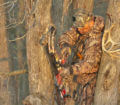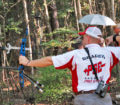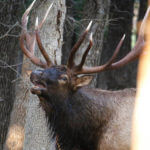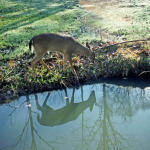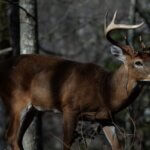Editor’s Note: Michael Braden (http://michaelbradenarchery.com/) of Houston, Texas, has won both ASA 3-D tournaments and IBO tournaments. He’s won numerous national championship titles and several Male Shooter-of-the-Year titles and is an avid bowhunter. He bought his first bow at a pawn shop in 1989, shot his first archery tournament in 1991 and became a professional staffer with PSE (http://pse-archery.com/) in 1996. As well as being a tournament archery shooter, Braden’s an archery coach.
 Phillips: Michael, how long have you been a coach?
Phillips: Michael, how long have you been a coach?
Braden: I started coaching in the mid-1990s. I was working at an archery shop and helping people learn how to shoot their bows. I’ve increased the amount of coaching I’ve done over the years.
Phillips: We usually think of an archery coach as being a coach for tournament archers. But does a bowhunter also need an archery coach? How can you help bowhunters?
Braden: Everyone in a shooting sport should have a coach. A coach keeps a person pointed in the right direction and helps him or her stay grounded in the fundamentals of shooting. A coach also teaches the proper techniques for many aspects of shooting to help prevent symptoms of target panic. Target panic is a difficult thing for some people to understand. The words bowhunters use to describe this are buck fever. Many people will see an archer shoot, and when the archer isn’t shooting as well as they think he should, they’ll say that the archer has target panic. As a hunter, you set yourself up to have target panic, because you believe you have to control the release at the very moment the animal stops or walks into a shooting lane. Too, because bowhunters are in the woods all day, sitting-still in tree stands for hours, they may be cold. But more importantly, the number-one problem bowhunters have is they believe they have to control their releases. That belief sets-up bowhunters for making a bad shot or missing the animals they’re hunting.
Phillips: Let’s use a bowhunter in a tree stand as an example. He has a 250- to a 300-pound 12-point buck in front of him that will score 150 or more on Boone & Crockett. This buck is the biggest one this hunter ever has seen. Now he has to stand, draw and make the shot. How does a bowhunter overcome this problem?
 Braden: That situation is exactly why a bowhunter needs a coach. The coach will teach you proper fundamentals and shot sequence and execution. Then when that animal presents that shot, you go through a shot process, rather than thinking about how many inches of bone are on that deer’s head.
Braden: That situation is exactly why a bowhunter needs a coach. The coach will teach you proper fundamentals and shot sequence and execution. Then when that animal presents that shot, you go through a shot process, rather than thinking about how many inches of bone are on that deer’s head.
Phillips: What’s the shot process?
Braden: The only reasons the hunter needs to look at the animal is to determine if it’s a shooter buck, how far away the animal is, and where the spot is on the animal that he’ll stare at to execute the shot. That’s the shooting sequence. You go through that same shot sequence just like you will in practice, or if you’re shooting a 3-D tournament. You decide if you’ll take the shot, what distance you are from the target and where on the target to place the arrow. Whether the target is paper or a deer, the process is the same. The second step is the execution of the shot. I come to full draw, take a deep breath, hold my breath, feel my anchor, wrap my finger around the trigger and let my finger touch the trigger. Then I get lost because I’m so intently focused on the spot I want to hit that I’m not conscious of the bow’s firing. Actually pulling the trigger on the mechanical release is a subconscious process that the hunter doesn’t need to think about.
To learn much more about bowhunting, get John E. Phillips’ eBooks, print books and audiobooks by going to https://johninthewild.com/books. For free information on making jerky from your deer to provide a protein-rich snack, you can download a free book from https://johninthewild.com/free-books.

